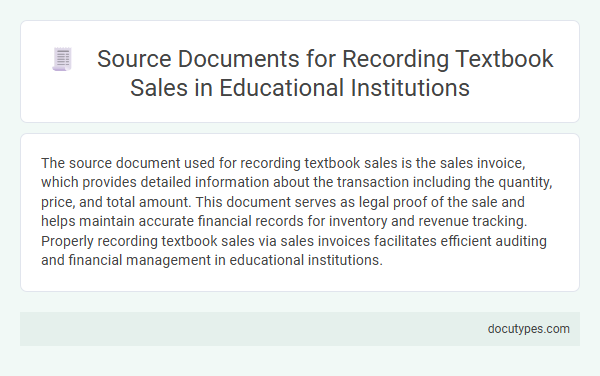The source document used for recording textbook sales is the sales invoice, which provides detailed information about the transaction including the quantity, price, and total amount. This document serves as legal proof of the sale and helps maintain accurate financial records for inventory and revenue tracking. Properly recording textbook sales via sales invoices facilitates efficient auditing and financial management in educational institutions.
Introduction to Source Documents in Educational Textbook Sales
Source documents are essential tools in recording textbook sales within educational institutions. These documents provide accurate and verifiable records of each transaction, ensuring proper accounting and inventory management.
In the context of educational textbook sales, the primary source document used is the sales invoice or sales receipt. This document details the number of textbooks sold, prices, date of sale, and buyer information, facilitating transparent and efficient record-keeping.
Importance of Accurate Documentation in Educational Institutions
The primary source document used for recording textbook sales in educational institutions is the sales invoice or receipt. This document captures essential details such as the textbook title, quantity sold, price, and date of transaction.
Accurate documentation of textbook sales ensures proper inventory management and financial accountability. Educational institutions rely on precise records to track sales trends and plan future textbook procurement effectively.
Common Source Documents for Textbook Transactions
| Source Document | Description | Purpose in Textbook Sales |
|---|---|---|
| Sales Invoice | Official document issued to buyers indicating books sold, quantity, price, and total amount. | Records the sale transaction and serves as a proof of purchase for textbook sales. |
| Delivery Receipt | Document confirming the delivery of textbooks to the customer, including details of the shipment. | Validates the transfer of ownership of textbooks from seller to buyer in sales records. |
| Purchase Order | Customer's document requesting specific textbooks for purchase, detailing quantities and titles. | Initiates the textbook sale process and serves as an order confirmation. |
| Cash Register Tape | Printed record from the cash register showing daily textbook sales transactions. | Supports daily sales totals and reconciliation for textbook sales accounting. |
| Sales Return Form | Document used to record returned textbooks from customers, specifying reasons and quantities. | Adjusts sales records and inventory for returned textbook items. |
| Receipt | Proof of payment issued to the buyer after textbook sale transaction completion. | Confirms payment receipt and finalizes the textbook sale record. |
Sales Invoices: Structure and Significance
Sales invoices serve as the primary source document for recording textbook sales, capturing essential transaction details. These invoices ensure accurate financial tracking and inventory management within educational institutions and bookstores.
- Invoice Number - A unique identifier for each sales transaction, facilitating easy reference and record-keeping.
- Item Description - Details of the textbooks sold, including title, edition, and quantity, to specify the exact products transacted.
- Transaction Date and Amount - The date of sale and total price, crucial for accounting and sales analysis.
Receipts as Proof of Textbook Purchases
The primary source document used for recording textbook sales is the sales receipt. Receipts serve as essential proof of textbook purchases, detailing the transaction date, items bought, and payment method. You should always retain these receipts for record-keeping and potential returns or audits.
Role of Delivery Notes in Textbook Distribution
Source documents play a crucial role in accurately recording textbook sales within the education sector. Delivery notes are essential in the textbook distribution process as they validate the transfer of goods from suppliers to educational institutions or retailers.
- Proof of Delivery - Delivery notes serve as official confirmation that textbooks have been received by the buyer.
- Inventory Management - They help track stock levels and update inventory records during textbook distribution.
- Sales Reconciliation - Delivery notes support the reconciliation of sales invoices with actual deliveries, ensuring accurate financial reporting.
Delivery notes provide reliable documentation that streamlines textbook sales recording and distribution workflows.
Purchase Orders for Textbook Procurement
Source documents play a critical role in accurately recording textbook sales within educational institutions. Purchase orders are essential for managing textbook procurement and ensuring proper transaction documentation.
- Purchase Order as a Source Document - A purchase order serves as the primary source document for recording textbook sales because it authorizes the purchase and specifies quantities, prices, and delivery details.
- Verification of Textbook Procurement - You use purchase orders to verify that textbooks ordered match the quantities received, providing an accurate record for sales and inventory management.
- Auditing and Financial Tracking - Purchase orders facilitate auditing by documenting textbook procurement and ensuring that textbook sales data is supported by authorized transactions.
Credit and Debit Notes in Textbook Sale Adjustments
The primary source document used for recording textbook sales adjustments is the credit and debit notes. Credit notes are issued to customers when textbooks are returned or when pricing errors are corrected, reducing the accounts receivable. Debit notes are used when additional charges are applied, such as for damaged books or late fees, increasing the amount receivable in the accounting records.
Maintaining Audit Trails in Textbook Sales
What source document is used for recording textbook sales to maintain accurate audit trails? The primary source document for recording textbook sales is the sales invoice or receipt. These documents provide a detailed record of each transaction, ensuring clear audit trails for financial accountability and inventory management.
What Source Document Is Used for Recording Textbook Sales? Infographic

